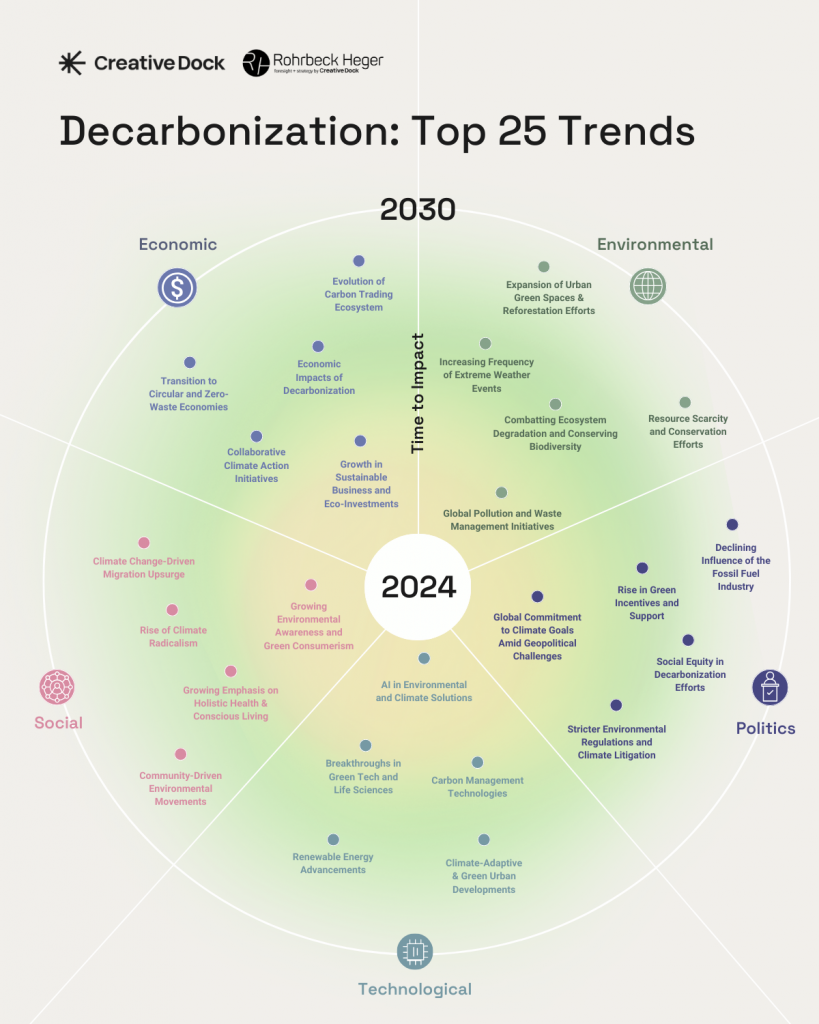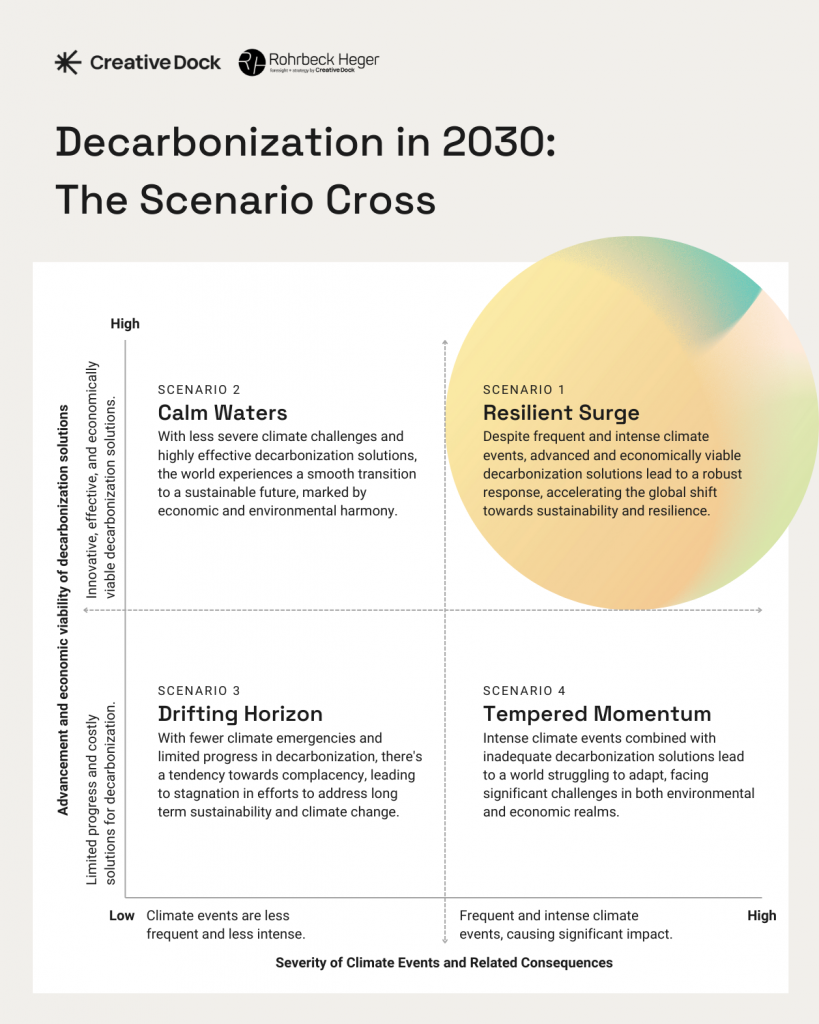
Top 10 Decarbonization Trends Shaping Our Future Towards 2030
As the impact of climate change becomes increasingly evident, the urgency of decarbonization is no longer a matter of debate, but a strategic imperative for businesses aiming not only to meet sustainability commitments but also to thrive in an uncertain future. Wondering what lies ahead? Dive into the top 10 trends that will define decarbonization towards 2030.
In this report, you will find information on our environmental, social, and economic impacts throughout 2023. It includes details of our efforts in areas such as reducing carbon emissions, ensuring fair labor practices, focusing on training and development, and promoting sustainable business practices throughout the organization.
In our latest foresight study on decarbonization, we identified the most significant trends across the STEEP framework, which covers five key areas: Social, Technological, Economic, Environmental, and Political. With the help of strategic foresight methods ranging from desk research to expert interviews, we conducted a thorough analysis, identifying 25 key trends.
Read up on the 10 most impactful trends below or explore the complete list – and more – in our study.
Download the full Decarbonization foresight study here.

Top 10 Decarbonization Trends
In light of an ongoing global shift towards sustainability and resilience, the following trends may significantly impact how the future unfolds. At the same time, they help us outline the challenges and opportunities on the path to decarbonization.
1. Climate-Change-Driven Migration Upsurge
The worsening of environmental conditions is directly linked to an upsurge in migration, which emphasizes the need for comprehensive policies and support systems to accommodate those displaced by climate impacts.
2. Growing Environmental Awareness and Green Consumerism
There is a notable shift in public awareness about environmental issues, increasingly influencing consumer behavior towards sustainable products and services. Also, grassroots activities spearhead environmental protection initiatives, including local conservation efforts, community gardening, and neighborhood sustainability projects.
3. Renewable Energy Advancements
A rapid transition is occurring in energy systems globally, with a shift towards renewable sources like solar, wind, and hydropower. This movement is driven by technological advancements, increasing affordability, and a growing emphasis on sustainability.
4. AI in Environmental and Climate Solutions
Artificial intelligence is increasingly being leveraged for environmental monitoring and climate change responses. AI’s data processing capabilities are crucial for predicting weather patterns, assessing environmental damage, and optimizing resource use.
5. Evolution of Carbon Trading Ecosystem
The carbon trading market is advancing and growing in both sophistication and influence. This encompasses the broadening scope of carbon credit systems, the development of emissions trading schemes, and the escalating significance of carbon pricing in shaping both corporate and national climate strategies.
6. Rising Demand for Supply Chain Transparency
Shareholders, employees, and customers alike increasingly demand accountability and transparency for sustainability claims. Organizations are facing increased scrutiny to embrace science-based targets, relying on verified reporting frameworks, to curtail carbon emissions throughout their supply chains.
7. Combatting Ecosystem Degradation & Conserving Biodiversity
A global movement to restore and protect natural ecosystems grows, with an increasing emphasis on biodiversity conservation. Habitat restoration, species protection, and sustainable land use practices are gaining traction, reflecting a commitment to ecological balance.
8. Expansion of Urban Green Spaces & Reforestation Efforts
Urban green spaces and reforestation initiatives are being expanded in response to the need for carbon sequestration and urban heat island mitigation. Urban forestry, park development, green urban planning, and the inclusion of vertical gardens in urban landscapes are becoming increasingly common.
9. Declining Influence of the Fossil Fuel Industry
The influence of the fossil fuel industry is diminishing as the world shifts towards renewable energy sources. This trend is marked by decreasing investments in fossil fuels, growing regulatory pressures, and a societal push for cleaner energy alternatives.
10. Stricter Environmental Regulations and Climate Litigation
Governments are implementing stricter environmental regulations, and there is an increase in climate-related litigation. These legal and regulatory measures aim to hold corporations and governments accountable for their environmental impact and drive more sustainable practices.
Methodology: From Trends to Future Scenarios
Our analysis doesn’t stop at trends. Once identified, they become building blocks of the so-called drivers of change. For instance, the rise in production of electric vehicles, combined with stricter environmental regulations and a rise in green incentives, make up a driver of change described as “a shift in transportation to more sustainable models.” Based on these drivers, we are able to map out sets of possible future scenarios like the ones presented in our study.

Out of the four plausible scenarios, we selected “Resilient Surge” as the subject of an in-depth analysis, as we believe it is vital in understanding the future ramifications of decisions made today. You can dive deeper into the “Resilient Surge” scenario, as well as its milestones, challenges, and implications in our Decarbonization study.
Future-proof your company strategy
Uncertainty is the name of the game when it comes to environmental and geopolitical changes, but with strategic foresight and an eagerness to understand these complex dynamics, your business can be at the forefront of green transformation. Replacing a survival mindset with resilience and determination to thrive despite and through uncertainty is crucial here. And proactively engaging with topics of global significance – such as decarbonization – is an excellent first step towards the future.
Get in touch with the Rohrbeck Heger team to find out how your organization can learn from future scenarios, stay attuned to evolving trends, and successfully navigate sustainable transitions with the help of strategic foresight.
Written by Marie Barvinkova
